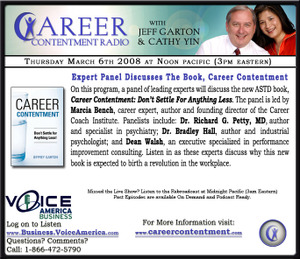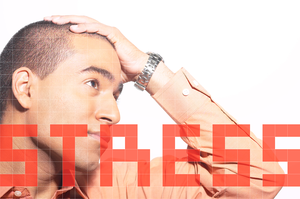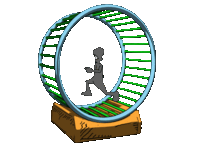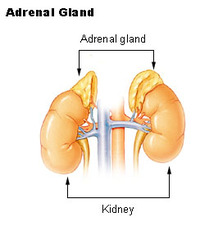Career Contentment

I am very happy to report that my friend Jeff Garton’s new book – Career Contentment: Don’t Settle for Anything Less – has just come out.
As you will see from my review, I just love the book, and it is amazing how Jeff’s work and mine fit together.
We are going to be having a panel discussion about the book on www.Business.VoiceAmerica.com on Thursday March 6th at 3PM Eastern, which is noon Pacific time. The discussion is also going to be archived for people in other time zones. I plan to put up a link as soon as it is available.
There is a nice press release here.
I hope that you can listen in: I think that you will get a lot of food for thought!
“Contentment is natural wealth, luxury is artificial poverty.”
-Socrates (Greek Philosopher, 469-388 B.C.E.)
Work, Stress, Vacations and Exotic Drinks with Little Umbrellas in Them

Your humble reporter has often spoken about his brush with burnout.
Even though I was a recognized expert on stress – and a former meditation teacher, no less! – I got perilously close to the edge. Fortunately someone noticed and I was packed off on vacation. It was remarkable that just a week in the Caribbean followed by an unforgettable one-week retreat in the Catskills was enough to cure me. My resting pulse rate fell from 68 to 48, where it stayed for more than a year, and I never again had any symptoms. The key point was that the short break was enough to interrupt the downward spiral and provoke the cognitive shift that prevented me from ever again making the mistakes that lead to the trouble in the first place.
I still work hard, but trust me when I say that working 16-17 hours a day, seven days a week is preposterous. Neglecting your emotional health and social life is bad enough. But the last straw was to stop engaging in spiritual practices that I had followed since childhood.
For a long time now I have been teaching that most people can make phenomenal changes in a very short period. It may take you a long time to prepare, but once you are ready change can be extremely quick. If you think about it, the actual physical business of an egg and a sperm joining to make a new life takes less than a minute. But the preparation for the event may take half a lifetime. At least I hope for your sake that it takes a lot longer than a minute…
And that’s all that I am going to say about that…
I was thinking about all this the other day when a stressed executive was telling me that he all he wanted was to spend six months sitting on a beach. In fact that would probably be a thoroughly bad idea.
It is not the time; it is the quality of the time, and the energy that you bring to it.
I cannot stress enough that for most people energy management is far more important than time management.
When it comes to beating burnout, the kind of vacation is likely more important than its length.
A summary of ten years of research by a team lead by Dov Eden, an organizational psychologist from Tel Aviv University’s Faculty of Management, was presented at last year’s meeting of “Work, Stress and Health” in Miami. The event is sponsored by the American Psychological Association and what Professor Eden had to say really supports what we have been talking about.
For the past ten years the team has been studying “respite effects,” which measure relief from chronic job stress during and after vacations away from the workplace. They have also been looking at the impact of constant contact: the revolution in telecommunications has kept some people permanently wired into the office while they are supposed to be away putting their feet up and drinking exotic concoctions with little umbrellas in them. So we are losing true “respite relief,” and that in turn is a cause of chronic job stress.
One recent study involved 800 professors from eight Universities in Israel, the United States, and New Zealand. The researchers measured stress levels before, during, and after a sabbatical leave of a semester or a whole year. They compared them with people who stayed home, and others who just took a long weekend or a one-week vacation. They found that those who took a long sabbatical break experienced about the same amount of stress relief as people who had taken either a week off or just a long weekend or long-weekend vacation. And all three groups returned to pre-sabbatical stress levels in about the same amount of time: approximately three weeks.
Some of Eden’s other studies have indicated that people who best succeed in uncoupling from work and detaching form its demands, get the most benefit from their vacations and they probably less likely to experience job burnout. It’s the ones who cannot detach from the constant flow of job-related demands that are most likely to suffer from burnout.
The key to a refreshing vacation is to create as much space as possible between you and your work life. I once knew someone who spent a week on Tioman Island in the South China Sea. It is reputed to be one of the most beautiful places on earth, which was one of the reasons why it was selected for the filming of South Pacific. For the whole week she spent all day every day working, and every day the hotel’s fax machine got jammed with the 60-70 pages that she sent out. That is not a recipe for a refreshing, life affirming vacation.
This body of research confirms what most sensible managers have worked out for themselves. When someone goes on vacation they should leave their cell phones behind and not check their email. People who feel attached to the office 24/7 are setting themselves up for long-term stress-related illnesses.
I get a lot more email and phone calls than most normal mortals, yet many years ago I made a remarkable discovery.
I had been out of contact for a week, and even after disposing of the spam and junk mail, there were still well over a thousand messages “demanding” my immediate attention. But during that week away, events had moved on, most no longer needed any input from me at all. Matters had been resolved and solutions found. We lost no business, and I have it on good authority that the earth did not fall into the sun.
I came back rested and restored, and firing on all cylinders: everyone benefited.
Quite obviously it is not a good idea to be completely un-obtainable. I have had two friends, one of whom lost her mother and another his wife, and neither heard the sad news for more than a week. So even when I am in some far flung part of the planet I make sure that there is a way for me to be contacted, But only three people know how.
And I am no longer an electron junkie.
Try it the next time that you have a chance. It really is easier than you think.
“Let all bitterness, and wrath, and anger, and clamor, and evil speaking, be put away from you, with all malice; and be ye kind to one another, tenderhearted, forgiving one another, even as God, for Christ’s sake, hath forgiven you.”
–The Bible, Ephesians 4:31-32
“Detach yourself from all that makes your mind restless. Renounce all that disturbs its peace. If you want peace, deserve it.”
–Sri Nisargadatta Maharaj (Indian Spiritual Teacher and Exponent of Jnana Yoga and Advaita Doctrine, 1897-1981)
“You must have been warned against letting the golden hours slip by, but some of them are golden only because we have let then slip by.”
–Sir James Matthew (J.M.) Barrie (Scottish Writer and Playwright, 1860-1937)
The Looming Crisis of Alzheimer’s

For those of us who lobby for resources, it is no overstatement to say that Alzheimer’s disease has reached crisis proportions in the United States.
As we are getting older, the incidence, prevalence and mortality of Alzheimer’s disease are all rising.
The 2007 Alzheimer’s Disease Facts and Figures report by the Alzheimer’s Association makes sobering reading. Here are some of the headline facts:
- Alzheimer’s disease is the most common cause of dementia
- At the present rate, one in 85 people will have the disease in 40 years
- There are now more than 5 million people suffering from Alzheimer’s disease, and the report projects an increase of 16 million cases by 2050 unless preventive measures are taken and/or science is able to come up with a prevention or cure
- One person is now diagnosed with dementia every seven seconds
- One in every four American families is affected by dementia
- The incidence of dementia is one in 1,000 before age 65 and one in 20 after age 65.
- More than $100 billion is spent per year on dementia, which is about 10 percent of all healthcare expenditures
As we have discussed before, the symptoms of dementia may be delayed for 3 to 5 years through healthy lifestyles and behavior modification, and there are many new treatment approaches in the pipeline.
The huge issue is that statistic about one in four families being affected by the disease. And it is a disease: it is not part of normal aging.
Caregivers can suffer terribly.
The Alzheimer’s Association also has some information for those who care for people with Alzheimer’s.
There is also some food information here concerning caregiver stress.
I would also like to direct you to some of the things that I have written here about the wellness of caregivers.
And for everyone, don’t wait until you are thirsty before you dig that well. Work on building you personal resilience and follow the simple lifestyle guidelines that may significantly reduce your risk of developing Alzheimer’s disease.
Running Scared

One very promising approach to understanding many psychological problems is to look at them from an evolutionary perspective: to see if clinical observations can be re-framed around the evolution of the brain.
Our brains are a hodgepodge of bits and pieces that have evolved over millions of years. We still have regions that evolved in reptiles, as well as the stunningly complex neocortex that has been developing over the last few hundred thousand years. Most of the time the different systems and circuits cooperate, but that cooperation falls apart if people are under the influence of alcohol or dugs, or in different types of neurological and psychological problems. Then the older and more “primitive” regions of the brain take over. That is typically what happens when a drunk wants becomes irritable or wants to fight. It is also what can happen in people who have sustained damage or have abnormal development of the frontal lobes of the brain. Alternatively it may happen if something over-stimulates the primitive regions of the brain.
Colleagues in London have been doing experiments with a computer game that could be immensely valuable for people with panic attacks and some types of anxiety disorders.
Working with healthy volunteers, Dean Mobbs and colleagues at the Wellcome Trust Centre for Neuroimaging at University College, London, used a Pac Man-like computer game, in which subjects were chased through a maze by an artificial predator. If caught, they received a mild electric shock.
At the same time, brain scans measuring blood flow showed that when the predator was a long way off, lower parts of the prefrontal cortex area of the brain were active. This region is associated with complex decision-making, such as planning an escape.
But when the predator moved closer, activity shifted to the periaqueductal gray area, which is responsible for rapid response survival mechanisms such as fighting, flighting or freezing.
This shows us that the brain’s response to fear changes as a threat gets nearer: the more impulsive region takes over from the decision-making regions as a threat looms closer. A problem in the balance between the two regions could explain some anxiety disorders. Most sufferers report that they “know” that their fears are illogical, but they react anyway. So the key question is what is it that shifts the balance of activities between the forebrain and midbrain regions of the brain?
This new research is published in the journal Science, and builds on similar findings in animals, including tests on rats that were performed at the University of Colorado in Boulder and published in 2005. In those experiments rats with a non-functioning prefrontal cortex did not cope with stress as well as those with normal brains.
From an evolutionary perspective, maintaining the correct balance between the different regions of the brain that handle fear help animals to avoid or escape predators.
There are some situations where we only have to be wary about potential threats, but other times we need to react without thought. The closer a threat, the more impulsive will be your response. If the threat is large enough and close enough we lose any semblance of free will and just take action.
Just as happens when someone is in the throes of a severe anxiety attack.
Evaluating Sense of Coherence

Yesterday we began to look at Aaron Antonovsky’s concept of Sense of Coherence.
Here is one of the most widely used sets of questions to determine an individual’s Sense of Coherence, derived from Antonovsky’s The Sense of Coherence Quest.
The questions concern a number of aspects of our lives.
Each question has seven possible answers. The person doing the evaluation marks one number from 1 to 7 for whichever one most closely corresponds to their beliefs or feelings.
1. When you talk to people, do you have the feeling that they don’t understand you?
Never 1 2 3 4 5 6 7 Always have this feeling
2 In the past, when you had to do something that depended upon cooperation with others, did you have the feeling that it:
Surely wouldn’t get done 1 2 3 4 5 6 7 Surely would get done
3. Think of the people with whom you come into contact daily, aside from the ones to whom you feel closest. How well do you know most of them?
You feel that they’re strangers 1 2 3 4 5 6 7 You know them very well
4. Do have the feeling that you don’t really care about what goes on around you?
Very seldom or never 1 2 3 4 5 6 7 Very often
5. Have you in the past ever been surprised by the behavior of people whom you thought you knew well?
Never happened 1 2 3 4 5 6 7 Always happened
6. Have you ever had people that you counted on, ended up disappointing you?
Never happened 1 2 3 4 5 6 7 Always happened
7. Life is:
Full of interest 1 2 3 4 5 6 7 Completely routine
8. Until now your life has had:
No clear goals or purpose at all 1 2 3 4 5 6 7 Very clear goals and purpose
9. Do you have the feeling that you’re being treated unfairly?
Very often 1 2 3 4 5 6 7 Very seldom or never
10. In the past ten years your life has been:
Full of changes without your knowing what will happen next 1 2 3 4 5 6 7 Completely consistent and clear
11. Most of the things you do in the future will probably be:
Completely fascinating 1 2 3 4 5 6 7 Deadly boring
12. Do you have the feeling that you are in an unfamiliar situation and don’t know what to do?
Very often 1 2 3 4 5 6 7 Very seldom or never
13. What best describes how you see life:
One can always find a solution to painful things in life 1 2 3 4 5 6 7 There is no solution to painful things in life
14. When you think about your life, you very often:
Feel how good it is to be alive 1 2 3 4 5 6 7 Ask yourself why you exist at all
15. When you face a difficult problem, the choice of a solution is:
Always confusing and hard to find 1 2 3 4 5 6 7 Always completely clear
16. Doing the things you do every day is:
A source of deep pleasure and satisfaction 1 2 3 4 5 6 7 A source of pain and boredom
17. Your life in the future will probably be:
Full of changes without your knowing what will happen next 1 2 3 4 5 6 7 Completely consistent and clear
18. When something unpleasant happened in the past your tendency was:
“To beat yourself up” about it 1 2 3 4 5 6 7 to say, “Ok that’s that, I have to live with it ” and go on
19. Do you have very mixed-up feelings and ideas?
Very often 1 2 3 4 5 6 7 Very seldom or never
20. When you do something that gives you a good feeling:
It’s certain that you’ll go on feeling good 1 2 3 4 5 6 7 It’s certain that something will happen to spoil the feeling
21. Does you have feelings inside you would rather not feel?
Very often 1 2 3 4 5 6 7 Very seldom or never
22. You anticipate that your personal life in the future will be:
Totally without meaning or purpose 1 2 3 4 5 6 7 Full of meaning and purpose
23. Do you think that there will always be people whom you’ll be able to count on in the future?
You’re certain there will be 1 2 3 4 5 6 7 You doubt there will be
24. Does it happen that you have the feeling that you don’t know exactly what’s about to happen?
Very often 1 2 3 4 5 6 7 Very seldom or never
25. Many people – even those with a strong character – sometimes feel like sad sacks (losers) in certain situations. How often have you felt this way in the past?
Never 1 2 3 4 5 6 7 Very often
26. When something happened, have you generally found that:
You overestimated or underestimated its importance 1 2 3 4 5 6 7 You saw things in the right proportion
27. When you think of the difficulties you are likely to face in important aspects of your life, do you have the feeling that:
You will always succeed in overcoming the difficulties 1 2 3 4 5 6 7 You won’t succeed in overcoming the difficulties
28. How often do you have the feeling that there’s little meaning in the things you do in your daily life?
Very often 1 2 3 4 5 6 7 Very seldom or never
29. How often do you have feelings that you’re not sure you can keep under control?
Very often 1 2 3 4 5 6 7 Very seldom or never
There are no right or wrong answers, but the overall pattern of your scores will give you some useful insights. There is a large research literature in which scores on this scale have been related to everything from career choices to the risk of getting PTSD.
A Sense of Coherence

One of the central concepts of Integrated Health and Integrated Medicine is the idea of coherence. This is not a new idea, but was developed in new ways and formalized by the American/Israeli sociologist Aaron Antonovsky. It is such an important concept that I have mentioned something about it before
Antonovsky developed his theory of health and illness, which he termed Salutogenesis. This model was described in his 1979 book “Health, Stress and Coping”, followed by “Unraveling the Mystery of Health”
in 1987. I remember its publication, and the strong feeling amongst many of us interested in Integrated Health that it was a most important
contribution to understanding the relationship between health and
illness. A key concept in Antonovsky’s salutogenic theory concerns the way in which
specific personal dispositions serve to make us more resilient
to the stressors that we encounter in daily life.
Antonovsky identified
these characteristics, which he said helped a person better cope and remain healthy by providing “a sense of coherence” (SOC) about
life and the challenges we all face. Measures of Sense of Coherence have
been developed and tested in more than 30 countries.
The SOC is defined as: “The extent to which one has a pervasive, enduring though dynamic, feeling of confidence that one’s environment is predictable and that things will work out as well as can reasonably be expected.”
So it tries to capture our sense of optimism and control.
SOC has three components:
- Comprehensibility
- Manageability
- Meaningfulness
Comprehensibility is the extent to which events are perceived as making logical sense, that they are ordered, consistent, and structured. Manageability is the extent to which a person feels they can cope. Meaningfulness is how much one feels that life makes sense, and challenges are worthy of commitment.
Professor Antonovsky believed that a person with a strong SOC is more likely to feel less stress and tension, and to have confidence that he or she can meet the demand placed upon them. The SOC was developed to apply across cultures, and versions of the questionnaire have been used in over 30 countries.
The SOC is not the only factor in a predicting outcomes in a person’s life: it interacts with a person’s natural coping style, upbringing, financial assets, mood and social support. The strength and availability of each is a major determinant in the development of a strong or weak SOC.
Research in the growing field of psychoneuroimmunology
has supported many of the basic assertions of the relationship between
emotions and health contained in Antonovsky’s theory of Salutogenesis.
I saw some research (NR691) at the 2007 Annual Meeting of the American Psychiatric Association in San Diego, California last month that was based on a sample of 976 working people in Denmark, found that people with a high sense of coherence perceive less stress and experience less psychological disturbance in the work place.
This all makes very good sense, and it also gives us yet another line of approach for helping people deal with the stresses of life and gain personal mastery.
I shall talk about using this information in the future.
Burnout and the Adrenal Glands

I have talked about burnout and the myth that it is caused by “adrenal fatigue.”
I saw some research (NR620) at the 2007 Annual Meeting of the American Psychiatric Association in San Diego, California last month that further nails the idea.
The investigators were from Ege University in Izmir, Turkey, and they looked at 37 people with burnout and did a battery of psychological and endocrine investigations.
The burnout group had:
- Higher levels of emotional exhaustion and depersonalization
- Higher depression and anxiety scores on the Beck depression and Beck anxiety inventories
- Higher scores on the global symptom index
The people with burnout did not have any differences in cortisol levels either at rest or after the investigators did a standard test to stimulate the adrenal glands. They reported exhaustion, but it was NOT caused by a problem with their adrenal glands.

I know that there are still plenty of people promoting the idea of adrenal fatigue, and there are many who sell their services online. The evidence that we have so far indicates that the adrenal glands of most people with burnout seem to be just fine.
DHEA: Hype, Hope and Disappointment
Dehydroepiandrosterone (DHEA) is a hormone that has attracted a lot of attention. It’s launched hundreds of websites, product lines and a few books and magazine articles. So what’s all the fuss about, and should we all be chomping down on DHEA tablets?
DHEA is manufactured at several sites in the body, but by far the most important is in one of the outer layers of the adrenal gland. Like all the steroid hormones it is made from cholesterol. It has various protective effects in the body, regulates some enzyme systems, can be converted to estrogen and under certain circumstances to testosterone. It has very weak androgen (male hormone) activity.
In cell culture it has a lot of other actions too, but it is always difficult to jump from effects seen using large doses in isolated cells, to giving advice on what supplements people should be taking.
There has been a lot of talk about the possibility that some people may, as a result of stress or toxins, suffer from exhaustion of the adrenal glands. There is a great long list of symptoms that may be caused by this so-called adrenal fatigue, deficiency or insufficiency: the terms are often – and incorrectly – used interchangeably. And therein lies the problem. It is such a long list that it is non-specific. It’s always a bit of a worry when someone tells me that dozens of different symptoms are all caused by one single biochemical problem. That just isn’t the way that the human body works.
I have seen and treated countless people with a condition known as Addison’s disease: true chronic adrenal insufficiency. It can be a very serious illness and it is quite different from the “adrenal fatigue” that people talk about in some popular books. People with chronic fatigue syndrome do have lower levels of activity in what is known as the hypothalamic-pituitary-adrenal axis, but it is not because the adrenal glands are not working properly, but because the hypothalamus in the brain is not doing it’s job properly. There’s also no proven link between “burnout” and adrenal function.
During my years as an endocrinologist and holistic physician, I’ve spent a great deal of time looking for adrenal fatigue in sick people and I’ve never found it. I’ve done all the tests recommended by proponents of adrenal fatigue and adrenal insufficiency and when we’ve done the tests properly, we’ve drawn a blank. There are a great many parallels between the adrenal insufficiency story, and the old – and discredited – myth about people becoming unwell because of a thyroid deficiency that cannot be picked up on standard thyroid function tests.
So can DHEA do you any good? Or can it be harmful? What exactly is the evidence?
- There is a comprehensive study, called The Dehydroepiandrosterone And WellNess (DAWN) study that should give us some solid answers as to the risks and benefits of DHEA. I shall post details of the findings as they become available. But some things we know already:
- DHEA has been touted as an anti-aging supplement. But in a two-year prospective study done in older people attending the Mayo Clinic in Rochester, Minnesota, neither DHEA nor low-dose testosterone replacement had physiologically relevant beneficial effects on body composition, physical performance, insulin sensitivity, or quality of life. Perhaps the people in the study didn’t get enough DHEA, but it doesn’t look that way. Instead it seems that just giving the supplement doesn’t seem to do very much. But there is increasing evidence that 50-100mg of DHEA each day will improve muscle strength and muscle mass in older people who are doing strength training. Once again, it does nothing in people who are not exercising. Sorry!
- According to the results of a small placebo-controlled, randomized trial published in the Archives of General Psychiatry, DHEA can be effective for midlife-onset minor and major depression. The study was conducted the National Institute of Mental Health Midlife Outpatient Clinic. In the trial, 23 men and 23 women aged 45 to 65 years with midlife-onset major or minor depression were randomized to six weeks of DHEA therapy, 90 mg/day, for three weeks and 450 mg/day for three weeks or to six weeks of placebo followed by six weeks of the other treatment. The subjects did not receive any other antidepressant medications during the study. Both of the doses of DHEA helped improve depression: there was no advantage in going to a higher dose, and there was no difference in the treatment response of men and women. The trouble with this study was not just the small size and the short duration, but the DHEA was not compared against a standard antidepressant. So we are still in the dark as to how effective it really is. It’s nice that it’s better than placebo, but this is just the first step in a larger research program.
- A study from Taiwan indicated that people with higher levels of DHEA sulfate had a lower overall mortality over a three-year period. That is interesting, but absolutely does NOT mean that artificially increasing our levels of DHEA with supplements will make us live forever: we don’t yet have that kind of magic bullet.
- In mice, quite large amounts of DHEA have the effect of slightly reducing the normal increase in stiffness of the left ventricle that can happen as animals get older. We have no idea whether something similar might help in humans, and the amounts of DHEA involved may rule it out as a viable treatment in people.
- 50mg/day improves subjective wellness in people who have no active pituitary gland. A rare condition, and we cannot use this evidence to advise healthy people about what to take.
- Because DHEA is converted into estrogen and/or testosterone, it may have the potential to exacerbate or initiate hormone-responsive tumors. The evidence is not strong one way or the other, but it remains a worry. I don’t think that anyone recommends DHEA to people who have a personal or family history of breast or prostate cancer.
There is a BIG literature on DHEA. But my current conclusions from all this?
- 50-100mg of DHEA is probably worth trying if you are over 50 years of age and doing regular exercise.
- It may help a bit with mild depression.
- It should not be used in people with a personal or family history of breast, prostate or any other type of hormone-sensitive cancer.
Beating Burnout
I have been getting a number of requests to re-post some of my materials about burnout.
This is a summary of some of the information that we cover in our corporate wellness seminars. For people who are interested, we have also created a Powerpoint slide set, together with reference materials which are available for purchase from our website.
So let us begin at the beginning and ask:
What is Burnout?
This may seem such an obvious question, since the term “burnout” has become part of everyday language, but it is still the topic of a great deal of research.
The best definition of burnout is “a prolonged response to chronic physical, emotional and interpersonal stressors at work.” It is defined by three dimensions:
- Exhaustion
- Cynicism
- Inefficacy
It is more than just an individual experience of stress: it has to be seen in the larger organizational context of people’s relationship with their work.
It is often the case that individuals miss all the signs in themselves.
So what are the main symptoms of burnout?
- Worrying, particularly at night
- Trouble sleeping
- Feeling unappreciated or “used” at work
- Feeling less effective or competent than you used to
- Easily angry or irritated
- Dread of going to work
- A feeling of being overwhelmed
- Recurrent stress-related physical symptoms like headaches, or back pain
- Watching the clock and counting down toward the end of the work day
- Rigidly applying riles without considering more creative solutions
- Automatically expressing negative attitudes
- Finding excuses to be absent from work
- Alcohol or substance abuse
We need to ask questions about conditions at work. For instance whether individuals are asked to work extra long shifts, go without breaks and lack clear guidelines.
Who is at greatest risk?
Helping professionals and people who have great responsibility for others, such as airline pilots and air traffic controllers.
Although there are some psychological predictors for who are more likely to suffer from burnout, with enough stressors just about anyone can become a victim of it. Some people have claimed that burnout is a physical illness resulting from exhaustion of the adrenal glands, but the research doesn’t show that. Burnout is primarily a problem of the system in which you work, interacting with your body and your mind. So now let’s look at how to transform yourself from victim to victor.
The major risk factors are:
- Feeling powerless
- Being caught in conflict
- Having inadequate information
- Lack of central visions
- Incoordination of the team
- Overload
- Boredom
- Alienation
- Ambiguity
- Conflict of values
What are the Solutions?
Dealing with burnout needs the help of all workers and the organization as a whole. Sometimes it also needs the help of an outsider. I was once working in a very unhappy place, in the days long before I realized that I had the power to change things myself. A psychologist friend working in the then new field of systems theory, told me that the problem was not with individuals, but that the whole system was “sick” and disorganized and what was needed was a system overhaul.
The opposite of job burnout is job engagement. If you feel that you are engaged in doing something valuable, for which you are appreciated, you are far more likely to have a satisfying life and enjoy doing your job well. There is good evidence that participation, engagement and autonomy are powerful predictors of health outcomes.
First, at the personal level:
The keys to preventing burnout are represented by the acronym REAP:
Resilience
Engagement
Autonomy
Participation
- Evaluate your personal goals and priorities: what do you really want to get out of life, and even more importantly, what do you want to put in to life
- Ensure that you have established your own core values, your purpose and your meaning. (My book and CD series Healing, Meaning and Purpose spends a lot of time on helping you do exactly that.)
- Attend to your own health, through exercise, nutrition and sleep. (I have worked with countless individuals with burnout, whose problems largely evaporated once they were diverted from the coffee, soda and snack machines. Remember the close relationships between food and mood.)
- Make sure that you have some outside interests. Not just things that further drain your energy, but something that you enjoy.
- Learn some specific stress reduction techniques. (I also have some suggestions for doing so in my book.)
- Are you a micromanager who has to do everything yourself? If so, then it is a really good idea to learn to delegate. And don’t take on responsibilities that are not yours. (It took me years to learn that one: I was such a slave to perfectionism, that I always thought that I had to everything myself. Bad mistake)
- If your find yourself expressing negativity, work on substituting a positive word for every negative one.
- Learn to forgive yourself if things are not going well, and use reversals as the fuel to power you to achievement: it’s what I call “silver-lining:” How to find the positive in any negative situation.
- Try to form a support group or see if you can arrange for an outsider to some in and help you.
- Are there some specific skills that you need to build and develop?
- Can you tailor or change your job?
- Develop detachment
Second, at the organizational level:
- Evaluate overall work performance: if it declining, it may be an early sign that staff members are being afflicted by burnout.
- Consider changes in managerial practices, to move away from the dominator to a partnership model.
- Research has indicated that there are six key areas in which mismatches may lead to burnout: workload; personal control; appropriateness of rewards; sense of connection; sense of fairness and a conflict of values. So it is a good idea to break down any analyses and interventions along these lines.
- All the evidence suggests that a combination of managerial change and education are the best way to head off and to deal with burnout.
- There is also some research showing that a values-based spiritual program to prevent and deal with burnout. The recommendations include a short time for silence, visualization, reflection, active listening, appreciation creativity and playfulness.
What is very clear is that burnout is not just a personal problem; it is something that can affect an entire organization, and has to be tackled as an organization. If it is not, then in these difficult times in health care, we are going to have ever more tired and disillusioned people trying to care for sicker and sicker patients, and just not having the resources to do so.
Transcending Overload and Burnout
There is an important notion that is rarely even talked about. Why does stress and burnout exist? Is it simply bad overloaded wiring in the brain and bad overloaded wiring in our relationships and in our places of work? Well, yes, that is of course correct. But there is also something else: burnout occurs because multiple sets of systems are failing. Nature abhors a vacuum, so from the ashes of these failed systems a new and improved you can emerge. Remember the ancient story of the Phoenix that emerges from the flames. And you might know the statement by Richard Bach: “What the caterpillar calls the end of the world, the master calls a butterfly.”
We need to discard broken systems so that our true self can emerge.
I would like you to think about burnout as a state of consciousness that you are ready to outgrow. You can practice the psychological band-aids, or you can accept the invitation to grow.
There will inevitably be some transition pains, but that is to be expected as the new you is being born. This is also a good time to do an exercise that I recommend in Healing, Meaning and Purpose, and it is to establish where each part of you – Physical, Psychological, Social, Subtle and Spiritual – lies in terms of the Memes of Spiral Dynamics. If you do this exercise every few months, and at times of transition, it can provide powerful proof that the burnout is actually presenting you with a unique opportunity to grow.
Exercise Burn Out
When we think about burnout, most of us concentrate on the psychological, relational and subtle aspects of the problem. But it is really important to be aware that just about any activity that isn’t balanced and moderated can burn us out.
I have just read a very nice article about avoiding workout burnout. We have all known youngsters who have so over-indulged in something like chocolate cake that they have become sick. Despite Mae West assuring us that “Too much of a good thing can be wonderful,” even the most positive of activities can turn around and bite us if not done in moderation. How many of us have returned to the gym and behaved like a bull in a china shop. And paid for it for the next three days….
One thing to add to this nice article. If you do over do it in the gym, and your muscles feel as if you’ve just gone ten rounds with Mike Tyson, you can usually reduce the period of pain and stiffness with the supplement Methylsulfonylmethane (MSM). So long as you are not sensitive to it, three 500mg capsules can be very helpful.
“Temperate temperance is best; intemperate temperance injures the cause of temperance.”
–Mark Twain (a.k.a. Samuel Langhorne Clemens, American Humorist, Writer and Lecturer, 1835-1910)
Technorati tags: Burnout Exercise Methylsulfonylmethane






